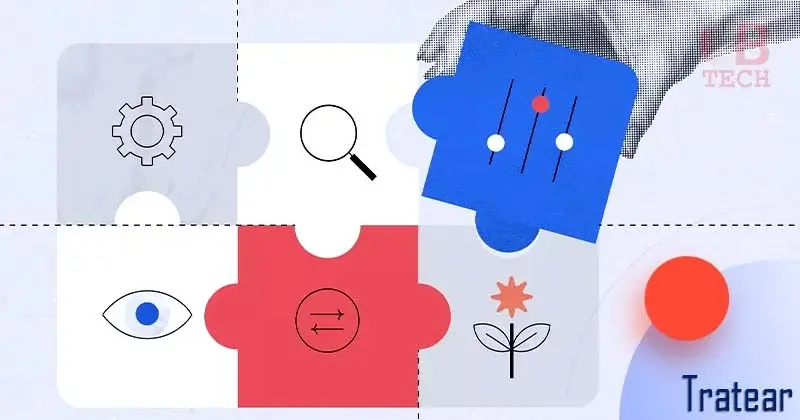In today’s fast-paced world, effective communication takes center stage in every interaction. Whether it’s in our personal relationships, professional settings, or educational environments, the skill of communicating effectively is highly valued. That’s where tratear comes in – a term that’s gaining traction in different fields for its innovative approach to communication.
The Essence of Tratear
Tratear isn’t just a term; it’s a groundbreaking concept that embodies a fresh perspective on interaction and problem-solving. This innovative approach is rooted in the Latin word “tractare,” which means to handle or manage, signifying a dynamic and versatile style of communication.
In our contemporary society, where collaboration and connectivity take center stage, tratear emerges as a vital element in cultivating effective communication. Its importance resonates across various sectors, from business negotiations to personal relationships, underlining its universal applicability.
Unlocking the Riches of Tratear
Embracing tratear brings forth a myriad of advantages that extend beyond the realms of conventional communication. This approach offers a pathway for heightened understanding, inventive problem-solving, and strengthened collaboration, transcending the limitations of traditional methods.
The essence of tratear lies in its remarkable ability to dismantle communication barriers. By doing so, it paves the way for more meaningful exchanges and interactions, fostering a climate where ideas can flow freely.
Distinguishing Tratear from the Conventional
In the realm of communication, what makes tratear stand out from traditional approaches? Unlike rigid structures seen in conventional methods, tratear champions fluidity, adaptability, and a solution-oriented mindset rather than dwelling on obstacles. Its dynamic nature empowers individuals to navigate complex situations with agility, making it the preferred choice in fast-paced environments.
Embracing Fluidity and Adaptability
Tratear thrives on the principles of fluidity and adaptability. It breaks away from the constraints of rigid communication methods, allowing for a more flexible and responsive interaction style that suits the ever-evolving nature of modern challenges.
Versatile Applications of Tratear
The utility of tratear extends across diverse settings, making its impact felt from boardrooms to classrooms and within the cozy confines of our homes. The principles of tratear find application in enhancing interactions, fostering collaboration, and cultivating a positive environment where communication can flourish.
Boardroom Dynamics
In the corporate realm, tratear brings a fresh perspective to boardroom dynamics. Its principles encourage open dialogue, creative problem-solving, and a focus on solutions, contributing to more effective and innovative decision-making processes.
Educational Environments
Within classrooms, the application of tratear transforms traditional teaching and learning approaches. It promotes interactive and collaborative learning, allowing students to engage with the material actively and develop critical thinking skills.
Positive Home Communication
Even within the intimate setting of our homes, tratear can enhance family communication. Its principles foster understanding, empathy, and effective problem-solving, creating a positive environment for healthy interactions among family members.
Navigating Challenges and Critics of Tratear
As tratear gains popularity, it encounters challenges that warrant acknowledgment and consideration. Critics contend that the fluid nature of tratear might introduce ambiguity or misunderstandings. It is crucial to address these concerns to maintain a balanced perspective on the concept.
The Fluidity Debate
One of the primary challenges raised by critics revolves around the fluid nature of “tratear.” Some argue that this very characteristic, while promoting adaptability, may also contribute to ambiguity in communication. Striking a balance between flexibility and clarity becomes a crucial aspect in addressing this concern.
Potential for Misunderstandings
Critics express concerns about the potential for misunderstandings stemming from the dynamic nature of “tratear.” The emphasis on adaptability may, at times, lead to varied interpretations, highlighting the need for clear communication guidelines to mitigate this challenge.
Acknowledging and addressing these challenges is essential to foster a comprehensive understanding of tratear and ensure its effective implementation in diverse scenarios. Feel free to share any specific viewpoints or modifications you’d like to incorporate!
Mastering the Art of Effective “Tratearing”
For individuals eager to elevate their communication skills through “tratear,” incorporating practical tips can significantly smooth the journey. Key aspects of successful “tratearing” involve active listening, adaptability, and a willingness to explore unconventional solutions.
1. Embrace Active Listening
Central to the art of “tratearing” is the practice of active listening. This involves fully engaging with the speaker, demonstrating genuine interest, and responding thoughtfully. By fostering a listening-first approach, you lay the groundwork for a more constructive and meaningful exchange.
2. Cultivate Adaptability
“Tratearing” thrives on adaptability. Being open to shifting dynamics and embracing change allows you to navigate diverse communication scenarios with ease. Flexibility in your approach fosters an environment where ideas can flow freely, contributing to more effective problem-solving.
3. Explore Unconventional Solutions
Breaking away from conventional thinking is a hallmark of “tratearing.” Encourage a mindset that explores innovative and unconventional solutions to challenges. This creative approach not only enhances problem-solving but also adds a dynamic and refreshing element to your communication style.
Inspiring Real-world Examples of Successful “Tratearing”
The success stories of tratear abound, showcasing its positive impact in various real-world scenarios. From businesses resolving complex issues to individuals navigating interpersonal conflicts, the application of tratear has consistently led to innovative solutions and strengthened relationships.
1. Business Resolution Through tratear
In the corporate realm, businesses have successfully applied tratear principles to resolve complex issues. By fostering open communication, encouraging creative problem-solving, and emphasizing collaboration, companies have found innovative solutions to challenges, leading to improved efficiency and decision-making.
2. Interpersonal Conflict Navigation
On a personal level, the application of tratear has proven instrumental in navigating interpersonal conflicts. By prioritizing active listening, adaptability, and a focus on solutions, individuals have been able to foster understanding and build stronger relationships, even in the face of disagreements.
3. Community Engagement and Problem-solving
Beyond individual and corporate contexts, tratear has found success in community engagement. When applied to address local challenges, this approach has facilitated inclusive discussions, encouraged diverse perspectives, and led to community-driven solutions that benefit all stakeholders.
Anticipating Future Trends in tratear
As technology advances at an unprecedented pace, the future of tratear presents exciting possibilities. The integration of artificial intelligence, virtual reality, and other emerging technologies holds the potential to further enhance the “tratearing” experience, shaping the way we communicate in the years to come.
1. AI-Powered “Tratearing” Enhancements
The integration of artificial intelligence (AI) into tratear processes is poised to revolutionize communication. AI algorithms can analyze communication patterns, offer real-time insights, and provide suggestions for more effective interactions. This dynamic combination of human intuition and AI assistance could elevate the “tratearing” experience to new heights.
2. Virtual Reality for Immersive Communication
Virtual reality (VR) presents an intriguing avenue for the future of “tratear.” By creating immersive communication environments, VR can enhance the sense of presence and collaboration, allowing individuals to engage in more authentic and impactful interactions, irrespective of physical distances.
3. Emerging Technologies in Collaborative Platforms
As collaborative platforms evolve, incorporating emerging technologies, the landscape of tratear is likely to transform. Features such as augmented reality (AR) interfaces, interactive visualization tools, and advanced data sharing capabilities could facilitate more dynamic and engaging communication, particularly in professional and educational settings.
These future trends in tratear underscore the ongoing evolution of communication practices, offering a glimpse into the exciting possibilities that lie ahead.
Clarifying Common Misconceptions about tratear
To truly understand the essence of “tratear,” it’s crucial to dispel some common misconceptions. Contrary to being a one-size-fits-all solution, tratear requires a nuanced understanding to leverage its benefits effectively.
1. Not a One-Size-Fits-All Solution
One prevalent misconception is viewing tratear as a universal fix for all communication challenges. In reality, it is a dynamic approach that adapts to different contexts. While it offers valuable principles, its application requires thoughtful consideration of the specific situation and individuals involved.
2. Nuanced Understanding is Key
Another misconception is assuming that the principles of tratear can be applied without considering its nuances. Successful implementation involves understanding the subtleties of communication dynamics, recognizing when to emphasize adaptability, active listening, or creative problem-solving based on the context.
3. Requires Contextual Awareness
Understanding that tratear is not a one-size-fits-all approach highlights the importance of contextual awareness. The success of “tratearing” hinges on recognizing the unique characteristics of each communication scenario and tailoring the approach accordingly.
Insights from Experts: Evaluating tratear
Experts from diverse fields have offered valuable critiques and reviews on the tratear communication approach. These evaluations present a comprehensive view of the strengths and potential limitations associated with this innovative method.
1. Strengths Recognized by Experts
Experts highlight the strengths of tratear in fostering open communication, promoting adaptability, and encouraging creative problem-solving. Its dynamic nature is praised for breaking down communication barriers, making it particularly effective in fast-paced and evolving environments.
2. Potential Limitations Explored
Despite its strengths, experts also explore potential limitations of “tratear.” Some caution about the need for clear communication guidelines to prevent misunderstandings, emphasizing the importance of balancing flexibility with clarity to maintain effective interactions.
3. Universality of Applicability
Experts acknowledge the universal applicability of tratear across various fields, from business to personal relationships. Its versatility is seen as a valuable asset, allowing individuals and organizations to tailor the approach to different contexts and communication challenges.
4. Call for Continuous Adaptation
A recurring theme in expert reviews is the necessity for continuous adaptation. As communication landscapes evolve, experts stress the importance of refining and expanding the principles of tratear to remain relevant in an ever-changing world.
By incorporating these insights, individuals can gain a more nuanced understanding of tratear and make informed decisions about its application in their respective fields.
Conclusion
In the whirlwind of our fast-paced world, effective communication stands as the linchpin in personal, professional, and educational spheres. Enter “tratear” – more than just a term, it’s a dynamic concept reshaping the way we interact and solve problems. Originating from the Latin “tractare,” meaning to handle or manage, tratear embodies adaptability, fluidity, and solution-focused dialogue.
As we navigate the contemporary landscape, tratear emerges as a vital element, breaking down communication barriers and fostering collaboration. Its versatile applications, from boardrooms to classrooms and homes, underscore its universal relevance. The success stories of tratear in real-world scenarios exemplify its transformative impact on businesses, interpersonal relationships, and community engagement.
Acknowledging challenges and critics, tratear prompts us to find a balance between its fluid nature and the need for clarity. Practical tips guide individuals to master the art of “tratearing,” emphasizing active listening, adaptability, and exploration of unconventional solutions.
Looking forward, the integration of artificial intelligence and virtual reality heralds exciting possibilities for tratear, promising to redefine communication in the years to come. However, it’s essential to dispel common misconceptions and maintain a nuanced understanding for effective implementation.
Insights from experts highlight the strengths and potential limitations of tratear, calling for continuous adaptation in our ever-evolving communication landscape. In conclusion, tratear isn’t just a buzzword – it’s a transformative force shaping the way we connect, collaborate, and communicate, ushering in a new era of dynamic and effective interactions.



